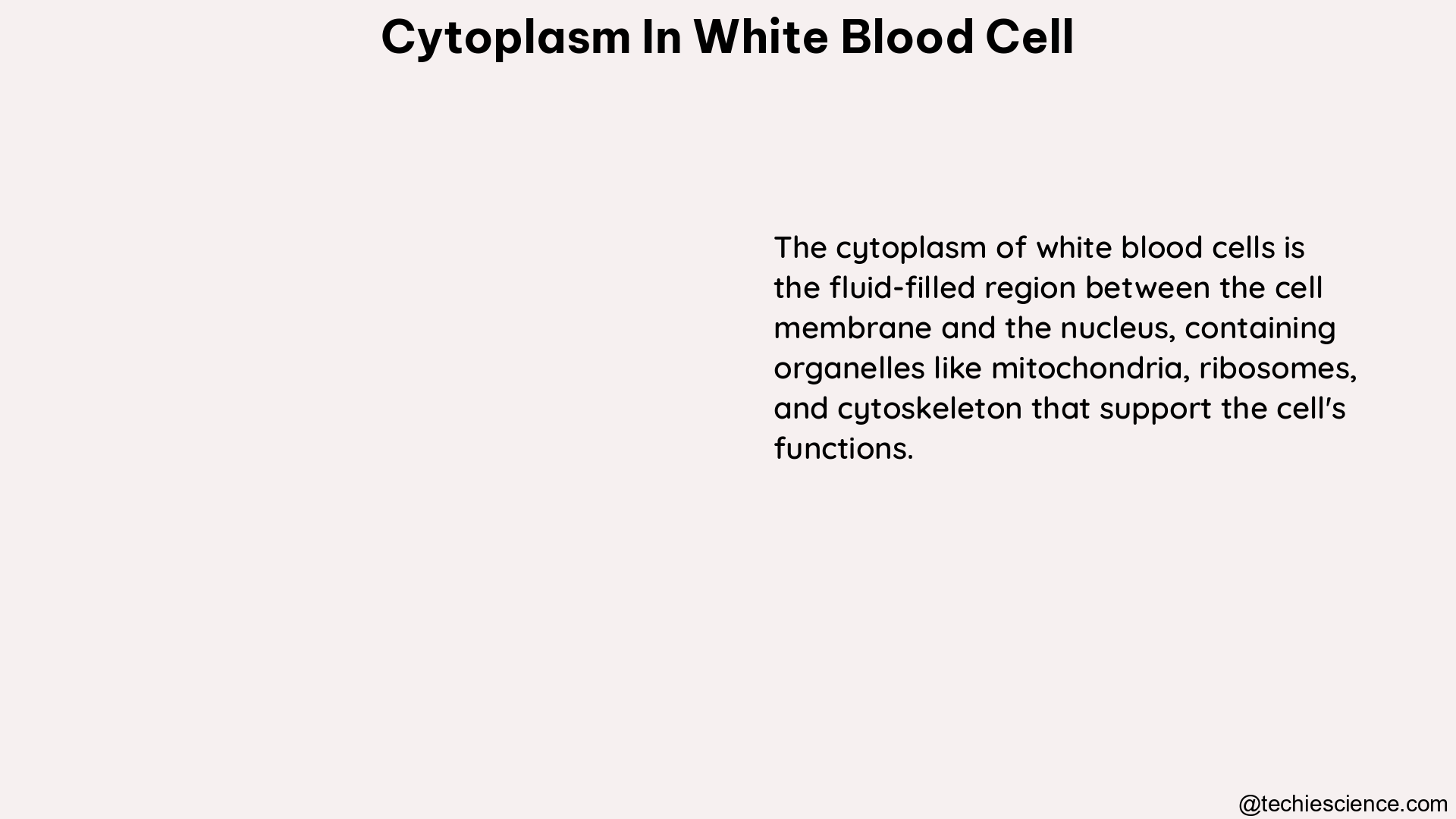The cytoplasm of white blood cells (WBCs) is a crucial component that plays a pivotal role in their functioning. It is the region between the cell membrane and the nucleus, where various organelles, such as mitochondria, ribosomes, and endoplasmic reticulum, are located. The cytoplasm of WBCs is responsible for several vital functions, including energy production, protein synthesis, and intracellular transport.
Understanding the Composition and Structure of WBC Cytoplasm
The cytoplasm of WBCs is a complex and dynamic environment, composed of a variety of organelles and molecules that work together to support the cell’s functions. Here’s a closer look at the key components of WBC cytoplasm:
Mitochondria
Mitochondria are the powerhouses of WBCs, responsible for generating the majority of the cell’s energy in the form of ATP through the process of oxidative phosphorylation. These organelles are highly abundant in the cytoplasm of WBCs, reflecting the high energy demands of these cells.
- Mitochondria in WBCs have a unique morphology, often appearing as elongated, tubular structures that can form interconnected networks.
- The number of mitochondria in WBCs can vary depending on the cell type and its functional state, with activated or proliferating WBCs typically having a higher mitochondrial content.
- Mitochondrial dysfunction in WBCs has been linked to various immune-related disorders, highlighting the importance of these organelles in maintaining proper WBC function.
Ribosomes
Ribosomes are the cellular factories responsible for protein synthesis in WBCs. These organelles are found throughout the cytoplasm, often concentrated in regions near the endoplasmic reticulum (ER), where newly synthesized proteins are processed and transported.
- WBCs have a high ribosomal content, reflecting their need for rapid and continuous protein production to support their diverse functions, such as phagocytosis, cytokine secretion, and antigen presentation.
- The distribution and density of ribosomes within the WBC cytoplasm can vary depending on the cell’s activation state and the specific proteins being synthesized.
- Disruptions in ribosomal function or protein synthesis in WBCs have been associated with various immunological disorders, underscoring the importance of this process in maintaining WBC homeostasis.
Endoplasmic Reticulum (ER)
The endoplasmic reticulum is a network of interconnected tubules and cisternae that extend throughout the cytoplasm of WBCs. The ER plays a crucial role in the synthesis, folding, and transport of proteins, as well as in the regulation of calcium homeostasis.
- In WBCs, the ER is particularly abundant and well-developed, reflecting the high demand for protein synthesis and processing in these cells.
- The ER in WBCs is often closely associated with the Golgi apparatus, which is responsible for the post-translational modification and sorting of proteins for secretion or membrane localization.
- Disruptions in ER function, such as the accumulation of misfolded proteins, can lead to ER stress and the activation of the unfolded protein response (UPR) in WBCs, which can have significant implications for their immune functions.
Cytoskeleton
The cytoskeleton is a dynamic network of filamentous proteins that provide structural support and facilitate intracellular transport in WBCs. The cytoskeleton is composed of three main types of filaments: actin filaments, microtubules, and intermediate filaments.
- The cytoskeleton plays a crucial role in the motility and migration of WBCs, allowing them to navigate through tissues and respond to chemotactic signals.
- Actin filaments are particularly important for the formation of pseudopodia and other membrane protrusions that facilitate phagocytosis and cell-cell interactions.
- Microtubules are involved in the intracellular transport of organelles, vesicles, and signaling molecules, which is essential for the coordination of WBC functions.
- Disruptions in the cytoskeletal organization of WBCs have been linked to various immune disorders, highlighting the importance of this structural network in maintaining proper WBC function.
Advances in Cytoplasm Imaging and Analysis

In recent years, researchers have made significant strides in developing advanced techniques for imaging and analyzing the cytoplasm of WBCs. These advancements have provided valuable insights into the structure, composition, and dynamics of the WBC cytoplasm, which can be leveraged to improve our understanding of WBC function and the development of new diagnostic and therapeutic approaches.
Segmentation Algorithms for Cytoplasm and Nucleus Extraction
Researchers have developed sophisticated segmentation algorithms that can accurately extract the ground truths of the cytoplasm and nucleus of WBCs from microscopic images. These algorithms have been applied to large datasets of WBCs, including lymphocytes, monocytes, neutrophils, eosinophils, and basophils, providing a valuable resource for the development of artificial intelligence in hematology.
- The ground truths extracted by these algorithms have been validated by expert annotations, ensuring the reliability and accuracy of the data.
- The availability of these datasets has enabled the development of advanced machine learning models for the automated classification and analysis of WBCs, which can have significant implications for clinical diagnostics and research.
- The segmentation algorithms have also been used to study the spatial organization and dynamics of the cytoplasm and nucleus within WBCs, providing insights into the functional relationships between these cellular compartments.
Transcriptome Analysis of WBC Cytoplasm
In addition to imaging-based approaches, researchers have also investigated the generalizability of the WBC transcriptome to the broader, multiorgan transcriptome. By leveraging data from the NCBI’s Gene Expression Omnibus (GEO) public repository, a study was able to define two datasets for comparison: the WBC set and the Other Organ (OO) set.
- The results of this study showed that a significant proportion of genes (48.8%) do not change more than 10% of their rank range between the WBC and OO datasets, and only 3.9% of genes change rank by more than 50%.
- This finding suggests that the WBC transcriptome can serve as an accessible window into the broader, multiorgan transcriptome, providing valuable insights into the molecular mechanisms underlying various physiological and pathological processes.
- The study also provided a quantitative measure of the probability of expression rank and correlation profile in the OO system given the expression rank and correlation profile in the WBC dataset, which can be useful for extrapolating WBC-based findings to other organ systems.
Flow Cytometry for Cytoplasmic-Nuclear Localization
Researchers have also developed rapid and efficient methods for quantifying the cytoplasmic versus nuclear localization of endogenous proteins in peripheral blood leukocytes using conventional flow cytometry. This approach allows for the assessment of the subcellular distribution of proteins in WBCs, which can provide insights into their functional roles and regulation.
- The flow cytometry-based method is particularly useful for studying the dynamic changes in protein localization within WBCs in response to various stimuli or disease states.
- By combining this technique with other analytical methods, such as transcriptomics or proteomics, researchers can gain a more comprehensive understanding of the regulatory mechanisms governing WBC function and their involvement in various physiological and pathological processes.
Conclusion
The cytoplasm of white blood cells is a complex and dynamic environment that plays a crucial role in the functioning of these essential immune cells. Through the advancements in imaging, segmentation, and transcriptome analysis, researchers have gained valuable insights into the structure, composition, and regulation of the WBC cytoplasm, which can have significant implications for our understanding of immune system function and the development of new diagnostic and therapeutic approaches.
By continuing to explore the intricacies of the WBC cytoplasm, researchers and clinicians can unlock new opportunities for improving the diagnosis, monitoring, and treatment of a wide range of immune-related disorders, ultimately leading to better patient outcomes and a deeper understanding of the human immune system.
References:
- White blood cells classification using multi-fold pre-processing and deep learning techniques. Nature Scientific Reports, 2024.
- A large dataset of white blood cells containing cell locations and types, along with segmented nuclei and cytoplasm. Nature Communications, 2022.
- Quantifying the white blood cell transcriptome as an accessible window to the multiorgan transcriptome. Bioinformatics, 2012.
- A rapid method for quantifying cytoplasmic versus nuclear localization in endogenous peripheral blood leukocytes by conventional flow cytometry. Cytometry Part A, 2017.

Hello, I am Piyali Das, pursuing my Post Graduation in Zoology from Calcutta University. I am very passionate on Academic Article writing. My aim is to explain complex things in simple way through my writings for the readers.